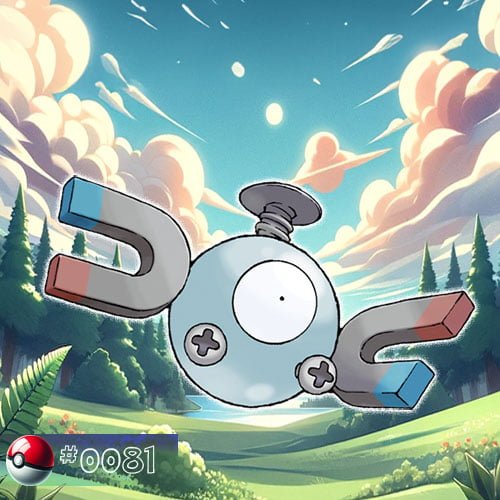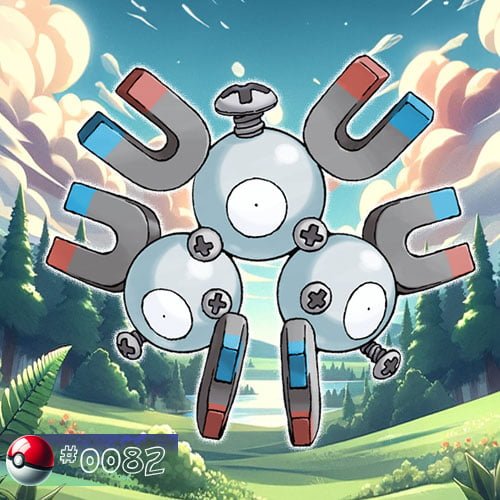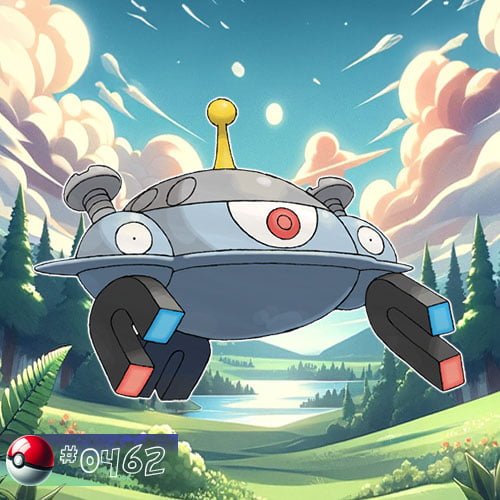Magnemite
Magnemite is an Electric/Steel-type Pokémon species in the Pokémon series. It is characterized by its metallic appearance and it can generate and manipulate electricity.
Biology
Physical Characteristics
Magnemite, a Pokémon known for its unique appearance, exhibits several distinct physical characteristics.
The metal spheres that make up Magnemite’s body are smooth and reflective, suggesting a polished and metallic surface. These spheres are composed of a durable material, providing protection and structural integrity to the Pokémon. Magnemite’s eye is often depicted as a singular lens or sensor situated on each sphere. The eye has a circular or ovular shape, and its color can vary in different depictions.
The magnetic forces generated by Magnemite’s magnets are powerful, enabling it to attract and connect with other Magnemite. These magnetic forces also grant Magnemite the ability to levitate, allowing it to navigate through the air effortlessly.
Magnemite’s metallic body is commonly silver or gray, resembling steel or other alloys. The coloration reinforces the idea of Magnemite being a man-made or artificial Pokémon, emphasizing its connection to technology.
Magnemite is typically small in size, with each sphere being a few inches in diameter. Its compact size makes it suitable for hovering and swift movement.
While the exact mechanism of Magnemite’s levitation is not explicitly detailed, it is inferred that the magnets create an anti-gravitational effect, allowing Magnemite to float. Magnemite’s design is consistent across various Pokémon media, including video games, anime, and official artwork.
Magnemite’s detailed design elements contribute to its role as an Electric/Steel-type Pokémon with a distinct robotic and technological aesthetic.
Behaviour
The behavior of Magnemite is shaped by its nature as an Electric/Steel-type Pokémon with unique physical characteristics. Here are details about Magnemite’s behavior.
Magnemite is attracted to strong magnetic fields, and it often congregates in areas where electromagnetism is abundant. This behavior explains its tendency to cluster together with other Magnemite to form larger structures. Magnemite has the remarkable ability to attract and connect with other Magnemite, forming a larger structure known as Magneton. The synergy between multiple Magnemite enhances their magnetic powers, creating a more formidable electromagnetic force.
Magnemite hovers in the air, suspended by its powerful magnets. This levitation ability allows Magnemite to move freely and explore its surroundings, unaffected by traditional constraints like terrain.
Magnemite possesses an inherent sensitivity to electromagnetic fields. It can detect changes in electromagnetic energy, which aids in navigation and helps it locate potential prey or sources of energy. Magnemite employs Electric-type moves in battles, utilizing its ability to generate and manipulate electrical energy. Thunder Shock, Magnet Bomb, and other Electric-type moves are common in Magnemite’s offensive repertoire.
Magnemite is often found in urban areas and locations with human-made electrical devices. This behavior showcases its adaptability to environments influenced by technology and electromagnetism.
When Magnemite evolves into Magneton, its behavior shifts from that of a singular entity to a cooperative group, emphasizing the communal nature of these Pokémon.
Trainers who capture Magnemite may find them to be loyal and responsive, forming a bond through training and battles.
Magnemite’s behavior is intricately linked to its Electric and Steel characteristics, emphasizing its connection to magnetism and technology. Its behaviors align with its role as a Pokémon associated with electricity and magnetic fields.
Evolution
Magnemite evolves into Magneton, and further evolves into Magnezone. Here are the details of Magnemite’s evolution.
Magnemite evolves into Magneton starting at level 30, where it will undergo a natural transformation into Magneton. Magneton is a conglomerate of three Magnemite, forming a triangular structure. The three Magnemite are linked by strong magnetic forces.
Magneton evolves into Magnezone under specific conditions. For Magneton to evolve into Magnezone, it needs to level up in areas with strong magnetic fields. The introduction of this evolution condition was introduced in later generations of Pokémon games. Magnezone has a more complex design compared to Magneton. It features a central core with three saucer-shaped magnets orbiting around it. Magnezone is larger and more advanced in appearance.
Magnemite, Magneton, and Magnezone are Electric/Steel-type Pokémon, emphasizing their association with magnetism and conductivity. These Pokémon are known for their abilities related to electricity and magnetic fields, such as Magnet Pull and Sturdy.
The evolution of Magnemite into Magneton and potentially into Magnezone highlights its affinity for magnetism and the electromagnetic forces it harnesses. The evolution process aligns with its theme as an Electric/Steel-type Pokémon and introduces variations in different regions.
Appearances
Anime Main Appearances
Clemont’s Magnemite
Clemont, the Gym Leader of the Lumiose Gym and a former traveling companion of Ash, has a Magnemite which debuted in “Clemont’s Got a Secret!” and is a resident at the Lumiose Gym.
Francois
Ren, one of Professor Cerise’s assistants, has a Magnemite affectionately nicknamed Francois, which accompanies him on his Pokémon journey.
Other appearences
Magnemite debuted in the episode “Sparks Fly for Magnemite”, aiding Ash during a power outage. It evolved into Magneton in “Get Along, Little Pokémon” to rescue Pikachu. In various encounters, Magnemite featured in battles, helped power stations, and served as a security guard. Jasmine and Wattson, each own Magnemite, using them in Gym battles (”Nerves of Steelix!” and ”Watt’s with Wattson?”).
Notable appearances include the episode “All Torkoal, No Play!” and “Camping It Up!” where Brock trained a Magnemite. In “Expedition to Onix Island”, a wild Magnemite attacked Iris and Axew. Instances of Magnemite under Team Plasma’s control are seen, and in “It’s All in the Name!” they go wild due to a magnetic storm in Vermilion City.
Anime Minor Appearances
A Magnemite featured in Pokémon Theme Park (”Pikachu’s Vacation”), worked as lighting technicians in ”Lights, Camera, Quack-tion”, and participated in a breeding competition in ”Beauty and the Breeder”. In ”As Clear As Crystal”, one was affected by a healing crystal. ”You Said A Mouthful!” showcased a Magnemite inside Pelipper’s mouth for Electric attacks.
Other appearances include ”A Fan with a Plan!”, ”Training Daze”, ”Lucario and the Mystery of Mew”, ”The Champ Twins”!, ”Sticking With Who You Know!”, ”Kalos, Where Dreams and Adventures Begin!”, ”Summer of Discovery!”, ”A Campus Reunion!”, and ”Lights! Camera! Pika!”, where it was employed by Frank for movie lighting. In ”I Choose You!”, a Magnemite fell under Marshadow’s control.
Multiple Magnemite appeared in the espiodes:
- ”Pikachu Re-Volts” (four Magnemite seen being controlled by Cassidy and Butch at Mandarin Island North)
- ”The Power of One” (disturbed by Lawrenec III)
- ”Pikachu’s Rescue Adventure”
- ”The Legend of Thunder!”
- ”Steeling Peace of Mind!” and ”Saving the World From Ruins!” (disturbed by Team Galactic’s interference on Iron Island)
- ”Gone With the Windworks!” (guarding the Valley Windworks)
- ”Iris and the Rogue Dragonite!”
- ”The Future Is Now, Thanks to Determination!” (controlled by Team Rocket)
- ”The Power of Us” (five of them owned by Trainers and one wild)
- ”Securing the Future!” (Trainers’ Magnemite were seen showering Necrozma with other Pokémon)
- ”A Crackling Raid Battle!” (four of them)
- ”This Could be the Start of Something Big!” (three of them)
A Coordinator’s Magnemite participated in the Arrowroot Contest in the episode ”Dawn of a Royal Day!”.
A Trainer’s Magnemite appeared also in the following epsodes:
- ”A Shocking Grocery Run!” (four owned by different Trainers)
- ”They Might Not Be Giants!”
- ”Crystal-Clear Sleuthing!”
- ”Balloons, Brionne, and Belligerence!” (Two Trainers’ Magnemite)
- ”Now You See Them, Now You Don’t!”
- ”Getting a Jump on the Competition!”
- ”Dummy, You Shrunk the Kids!”
- ”Turning the Other Mask!”
- ”Heart of Fire! Heart of Stone!”
- ”The Dealer of Destruction!” (Two Trainers’ Magnemite)
- ”A High-Speed Awakening!”
- ”The Final Four!” (two of them, one owned by Trainer)
- ”Exhibition Unmasked!”
- ”Legend? Go! Friends? Go!” (participated in a Raid Battle against a Lugia)
- ”The Sinnoh Iceberg Race!”
- ”A Chilling Curse!”
- ”Restore and Renew!”
- ”Getting More Than You Battled For!”
- ”Aim For The Eight!”
- ”Helping the Hometown Hero!”
- ”The Bittersweet Truth”
- ”HZ039”
Manga Appearances
Pokémon Adventures
Multiple Magnemite debuted on the S.S. Anne in ”Danger: High Voltorb”, ready to attack Red. Their ownership is uncertain. They reappeared in ”Buzz Off, Electabuzz!”, searching for Red on the ship.
In ”Holy Moltres”, a Team Rocket Grunt used a Magnemite against Blaine’s Arcanine and Rapidash. Lt. Surge employed two Magnemite to trap Red in ”Go for the Golbat”.
In ”Lapras Lazily”, a wild Magnemite appeared in the abandoned Power Plant during Blue’s flashback. Later, in ”Electro Magneton”, three wild Magnemite and a Magneton attacked Blue and Evan, escaping after Blue’s Machamp defeated the Magneton.
Magnemite appeared in other various Pokémon Adventures chapters, with Lt. Surge using one to get Morty’s attention (”Magnificent Magnemite”). Another Magnemite joined the fight in Ilex Forest during ”The Last Battle XIII”. Wattson and Ty had Magnemite that engaged in battles (” Plugging Past Electrike I” and ”What Would You Do for a Whismur?”), and a Magnemite from the Battle Tower was stolen by Guile Hideout (”The Final Battle VII”). Multiple Magnemite featured in events like a Prism Tower blackout (”Pangoro Poses a Problem”)and a tournament.
Pokémon Pocket Monsters
Green captured a Magnemite in ”Good Luck at the Big Pokémon Athletic Meet!” and used it for various adventures. Additionally, a Magnemite participated in a baseball match (”Fierce Competition at the Pokémon Baseball Tournament!), while Giovanni’s Magnemite had encounters with Squirtle in battle (”Squirtle, the Crybaby Pokémon”). Another Magnemite made an appearance at ”Pikachu’s Birthday Party”.
Magnemite also appeared in the following Pokémon manga:
Magical Pokémon Journey – in the episode ”How Do You Do, Pikachu?”.
Pocket Monsters Diamond & Pearl – in the the twenty-fifth chapter of the Pocket Monsters Diamond & Pearl manga, PDP25.
Pocket Monsters HGS – in the the sixth chapter, PMHGSS06 (multiple) and eleventh chapter of the Pocket Monsters HGSS manga, PMHGSS11.
Pokémon Gold & Silver: The Golden Boys – in the episodes ”Let’s Aim For The Goal!”and ”Gold and Black VS Team Rocket” (owned by Black).
Pokémon Zensho – in the third chapter of the Pokémon Zensho manga, PZ04 (owned by Lt. Surge, the Gym Leader of Vermilion City’s Gym).
Game data
Stats
Location
| Game version | Location |
|---|---|
| Pokémon Red and Pokémon Blue | Power Plant |
| Pokémon Yellow | Route 10, Power Plant |
| Pokémon Gold and Pokémon Silver | Routes 6, 11, 38, and 39 |
| Pokémon Crystal | Routes 6, 11, 38, and 39 |
| Pokémon Ruby and Pokémon Sapphire | New Mauville |
| Pokémon FireRed and Pokémon LeafGreen | Power Plant |
| Pokémon Emerald | New Mauville |
| Pokémon Colosseum | Trade |
| Pokémon XD | Trade |
| Pokémon Diamond and Pokémon Pearl | Fuego Ironworks |
| Pokémon Platinum | Route 222, Fuego Ironworks |
| Pokémon HeartGold and Pokémon SoulSilver | Routes 6, 11, 38, and 39, Safari Zone |
| Pokémon Black | Trade |
| Pokémon White | White Forest |
| Pokémon Black 2 and Pokémon White 2 | Virbank Complex |
| Pokémon X and Pokémon Y | Breed Magneton or Magnezone |
| Pokémon Omega Ruby and Pokémon Alpha Sapphire | Route 110, New Mauville |
| Pokémon Sun and Pokémon Moon | Trainers' School, Hau'oli City, Malie City, Poké Pelago |
| Pokémon Ultra Sun and Pokémon Ultra Moon | Trainers' School, Hau'oli City, Malie City |
| Pokémon: Let's Go, Pikachu! And Pokémon: Let's Go, Eevee! | Power Plant |
| Pokémon Sword and Pokémon Shield | Trade |
| Pokémon Brilliant Diamond and Pokémon Shining Pearl | Fuego Ironworks, Spacious Cave, Whiteout Cave, Icy Cave, Glacial Cavern |
| Legends Arceus | Cobalt Coastlands: Space-time Distortions |
| Pokémon Scarlet and Pokémon Violet | East Province (Area Two), East Province (Area Three) |
Magnemite's origin name
English: The name “Magnemite” is a combination of “magnet” and “mite.” “Mite” in this context refers to a small or diminutive creature.
Japanese: In Japanese, Magnemite is known as “コイル” (Koiru) This name is derived from the English word “coil,” emphasizing the coil-like structure often associated with electromagnets.
German: In German, Magnemite is named “Magnetilo. This name is a combination of “Magnet” (magnet) and the diminutive suffix “-ilo.”
French: In French, Magnemite is called “Magnéti. Similar to English, it combines “Magné” from “magnétique” (magnetic) and the diminutive “-ti.”
Spanish: The Spanish name for Magnemite is “Magnemite. It retains the English name, adapted to Spanish phonetics.
Italian: In Italian, Magnemite is known as “Magnemite. Similar to Spanish, it preserves the English name with Italian pronunciation.
Korean: The Korean name for Magnemite is “코일” (Koil) This name is a direct transliteration of the Japanese name “Koiru.”
Chinese (Simplified): In Simplified Chinese, Magnemite is known as “小磁怪” (Xiǎo Cígùai). “小” (Xiǎo) means small, and “磁怪” (Cígùai) is a combination of “磁” (cí), meaning magnetic, and “怪” (guài), meaning strange or monster.
Chinese (Traditional): In Traditional Chinese, Magnemite is also known as “小磁怪” (Xiǎo Cígùai). The characters used are the same as in Simplified Chinese.
These names across different languages reflect the Pokémon’s magnetic and electric attributes, emphasizing its connection to electromagnetism.





